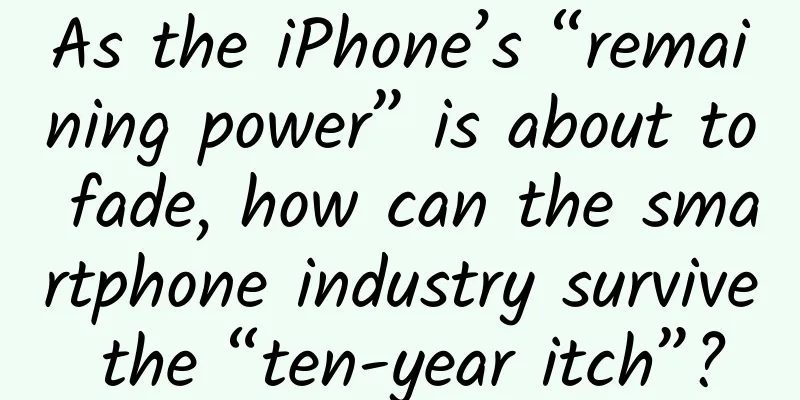As the iPhone’s “remaining power” is about to fade, how can the smartphone industry survive the “ten-year itch”?

|
It turns out that not only our country’s economy is going from bad to worse, but also the global smartphone market is going from bad to worse. On the evening of May 11, Bloomberg News expressed such a view on the prospects of the smartphone industry in an article based on an analysis of "various signs." The "various signs" mentioned here mainly refer to the fact that the prospects of Apple, which can almost be called the "invincible team" in the smart phone market, are not optimistic. The unprecedented weakness in sales of iPhone 6s/6s Plus has become an indisputable fact, which directly led to Apple's very unsatisfactory performance in the second quarter of fiscal year 2016. The performance of upstream suppliers was even more obvious. Pegatron, an iPhone assembler, and Minebea, a Japanese manufacturer that mainly provides LED modules for the iPhone, saw their net profits decline by more than 35% year-on-year and their net losses by nearly $300 million, respectively. The smartphone industry is entering its tenth year of hardship From a certain perspective, it is precisely because the release of the first generation iPhone in 2007 set the tone for the form of smartphones, and the subsequent rise of Google's Android provided competitive capital for other manufacturers, that the journey of smartphones in the past decade has been so exciting. The pioneering iPhone has continuously expanded its unique advantages from the initial multi-touch and high-resolution screen to Siri and Touch ID. On the other hand, the Android world with many brands is simultaneously engaged in a technical competition including the number of processor cores and camera pixels. Especially since Xiaomi, the efforts of domestic brands have brought about a groundbreaking change in the pricing structure of smartphones. But by 2016, we can clearly feel that the potential of smartphones is running out. The processor performance is so excessive that in daily use, you can only distinguish between low-end and high-end products by the heat level. The fingerprint recognition that was once high-end has even become a standard feature of thousand-yuan phones. Unless you are a person who likes novelty and dislikes old things, there is really no reason to pay attention to the next new phone. What's even more frightening is that the iPhone 7, which is tasked with counterattacking, is also not favored by the industry. Of course, objectively speaking, this is not surprising. After all, Apple has violated Steve Jobs' principle and enlarged the phone. The 3D Touch on the iPhone 6s is seen as a "useless" innovation. Even the iPhone 5s, which was released three years ago, has been sprayed with rose gold and "re-listed". Apple is also at a dead end. The tenth year of smartphones has undoubtedly encountered difficulties. What tricks can help smartphones “extend their lives”? The maximum number of smartphones in the market is certain. In reality, almost everyone has one smartphone, so smartphones have already reached a considerable high point. To stimulate consumers to upgrade their smartphones, sufficient appeal must be created in the products. Finding new usage and interaction scenarios is naturally the most direct and effective means, but today's mobile phones have integrated multiple identities such as communication, games, music, video, and Internet devices, and it seems that there will be no better substitute for touch operation for a long time. Some people pin their hopes on the popular VR, but before HTC, Oculus and Sony succeeded, VR on mobile phones was obviously still a distant ideal country. On the other hand, the actions of domestic manufacturers are more direct, that is, to make smartphones worthless again. The original positioning of domestic mobile phones was often concentrated on the main price range of 1,000 yuan and 2,000 yuan. In the past five months of this year, more and more domestic brands have begun to try to further subdivide product positioning in the price range of less than 1,000 yuan. Under the same brand, there are more and more mobile phone models that are less than 1,000 yuan. If the cost performance is really not a good thing, then the simple and crude idea of domestic manufacturers must be just a short-term "heart-saving pill" that I don't know if it will be of much use. So, maybe what the smartphone industry really needs is another thoroughly revolutionary product like the iPhone in ten years, similar to when Steve Jobs used two fingers to enlarge photos on the phone screen and used gravity sensing to turn the phone sideways to watch videos, making people immediately want to throw away the mobile phone with a T9 keyboard in their pocket, even though the iPhone was also full of controversy back then, and even though no one can predict what the next radical change will be like. Unfortunately, Apple under Cook's leadership lacks the courage to reshape the iPhone, and the entire smartphone industry has not yet produced the next decision-maker who can match Jobs. If the iPhone 7 repeats the situation of the iPhone 6s, then the crisis of the smartphone industry after a decade of fierce growth may really come. As for the seemingly prosperous domestic smartphones, when can they get rid of the hat of "parts assembly factory"? This is a problem that has not been solved in the past ten years. As a winner of Toutiao's Qingyun Plan and Baijiahao's Bai+ Plan, the 2019 Baidu Digital Author of the Year, the Baijiahao's Most Popular Author in the Technology Field, the 2019 Sogou Technology and Culture Author, and the 2021 Baijiahao Quarterly Influential Creator, he has won many awards, including the 2013 Sohu Best Industry Media Person, the 2015 China New Media Entrepreneurship Competition Beijing Third Place, the 2015 Guangmang Experience Award, the 2015 China New Media Entrepreneurship Competition Finals Third Place, and the 2018 Baidu Dynamic Annual Powerful Celebrity. |
<<: Bloomberg: Global smartphone market will go from bad to worse
Recommend
Occupational Disease Prevention and Control Law Promotion Week丨How to avoid the "little earthworms" on your legs?
The Occupational Disease Prevention and Control L...
Watch Joy of Life online for free, watch Joy of Life online for free full version and high definition!
When Fan Xian was fifteen years old, his father F...
Breaking News | Tik Tok short video marketing secrets: vertical screen advertising 1+1"!
Quick Facts 1. Summary of mobile phone vertical s...
He is the prototype of the movie! The hero who first bombed the Watergate Bridge is still alive, he is 98 years old!
The movie "Watergate Bridge at the Changjin ...
Ideas for building a Baidu promotion account, how to build a Baidu search engine account?
Many friends don’t know where to start when they ...
SAIC-GM has no way to save itself by cutting production and laying off employees. It is better to follow Volkswagen's example and rely on domestic brands as soon as possible.
Toyota, Honda, and Nissan all fell in price. Japa...
Why are there so many asymptomatic infections? How to prevent them? Zhang Boli's latest response
For several consecutive days, among the newly rep...
My child has a big head and short limbs. Could he be suffering from achondroplasia?
《Cotton Swab Medical Science Popularization》 Yong...
What is the connection between neural networks and mathematics? You will understand after reading this
Those of us who have learned about neural network...
Trump suggests postponing the 2020 US election. When will it be?
On Thursday (July 30), U.S. President Trump poste...
Latest Age Regulations for Construction Workers 2022: What is the age limit for migrant workers on construction sites?
In rural areas, many farmers are forced to work i...
Useful Information | How to plan a public account operation plan?
I'm currently working on an overall operation...
DeepMind's latest research: AI beats humans and designs better economic mechanisms
“Many of the problems facing humanity are not sim...
Playing with photography HTC is pushing itself into the abyss of darkness
Is it time? Is it fate? Often, the development of...
The secret to making Tik Tok video ads a hit!
How to shoot a good Douyin video with strong sale...









